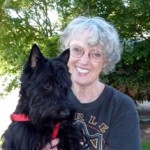Jeri Chase Ferris remembers being twelve years old and riding her black Arabian mare through the golden wheat fields of Nebraska under steel gray thunderheads. “That combination…is seared in my memory,” she says. Perhaps it was the dramatic contrast of colors. Perhaps it was Ferris’s first attempt as a future writer to record an event of visceral importance. In hindsight, she reflects that her own age during her most vivid memory is the same age as most of her readers today. Ferris says, “I didn’t want to be a writer. I read all the time, but I never thought that someone had to write those books.”
Teaching inner-city students inspired Ferris to write for children. “I taught in Los Angeles for 30 years,” she says. “I wanted books for my students with good role models. I couldn’t find many books about people of color who made a difference so I decided to write them myself.” Ferris enrolled in a children’s writing class at UCLA in the late 1980s taught by Caroline Arnold, a prolific nonfiction author with more than 140 books to her credit. Ferris’sGo Free or Die began as a project for this class. “I was teaching third grade at the time,” she says, “and [Harriet Tubman] popped into my mind as a dramatic character to write about, running away escaping the slave catchers.” After two rejections, Ferris submitted her manuscript to Lerner Publishing and found herself in the right place at the right time. “Lerner was becoming aware that there should be biographies of people of color,” Ferris says, “and I suggested several.” Ferris not only sold Go Free or Die, but signed a contract for three additional books.
Ferris is a three-time winner of the Carter G. Woodson Award for the most distinguished books for young readers depicting ethnic diversity in the United States. Her biographies delve into the lives of eleven multi-cultural figures, including Sojourner Truth, Biddy Mason, Mary Ann Shadd Cary, Marian Anderson and Matthew Henson. Sometimes a line in a newspaper or magazine article will lead Ferris on a quest for information about an unfamiliar person. The acid test of a viable biography for Ferris is her subject’s courage. The courage of her characters inspires Ferris, which in turn inspires her readers. One letter from a young fan says, “You made me see I can be anything I want to be.” According to Ferris, the idea stage is the most difficult. “Lots and lots of times, it’s a dead-end or the person has been done to death so there’s no point in [writing about] him again, but then I find just the right person and our souls meet somewhere and I’m drawn to that person’s life and the hardships that person had to overcome.”
The next phase of a book project is the research—Ferris’s favorite part. During school visits, she tells students that when she was young she wanted to be a jockey, a librarian or an archaeologist. In the midst of reading letters and diaries, combing historical society and newspaper archives, devouring every book about her subject that she can find, and traveling to speak to surviving family members, Ferris is like an archaeologist digging through facts to reconstruct the story of her subject’s life. “I love sinking into the period and surrounding myself,” she says, “and closing my eyes like a film is running and I’m participating.”
Recently, Ferris reworked a previously published biography for older children on Noah Webster into a picture book biography. Four publishers haggled over Noah Webster and His Words, with Houghton Mifflin Harcout emerging as the winner. Ferris’s first nonfiction picture book will debut in 2011.
In the meantime, Ferris plans to jump into fiction with a middle grade novel about the siege of Leningrad. Although she does not yet have a contract, the topic is close to her heart. Ferris’s husband, Tom, used to teach Russian studies at Beverly Hills High School. In 1970, they took a class on a field trip to the Soviet Union and the Ferrises developed a passion for the Russian people who endured the Soviet era. “The history, culture, people, architecture, art, music, language, tragedy and turmoil was like a magnet that sucked us into the heart of Russia,” she says. Together they traveled to what used to be the USSR over 30 times and amassed a collection of over 8,000 Soviet artifacts currently housed at the University of Southern California and described as “exceptional and unconventional” and a “precious and unprecedented research tool.”
After Tom’s death, Ferris says, “I couldn’t stay in Los Angeles where we lived for 40 years. I wanted to be back on the prairie and have a horse again.” Ferris moved to Lincoln, California and adopted a half-draft/ half-Thoroughbred rescue horse that she namedPamyat, Russian for “to remember.” Although Ferris retired from teaching children, she remains active teaching writing to adults; learning to speak Russian; volunteering at her church; and staying fit by clogging, an energetic, rhythmic dance that reminds her of her percussion days in her high school band.
“I do my best to write in the late afternoon and evening,” she says, using that “aloneness” to enter her character’s world and become that person for a few hours at a time. “I have to be that person or it’s just not working.”


